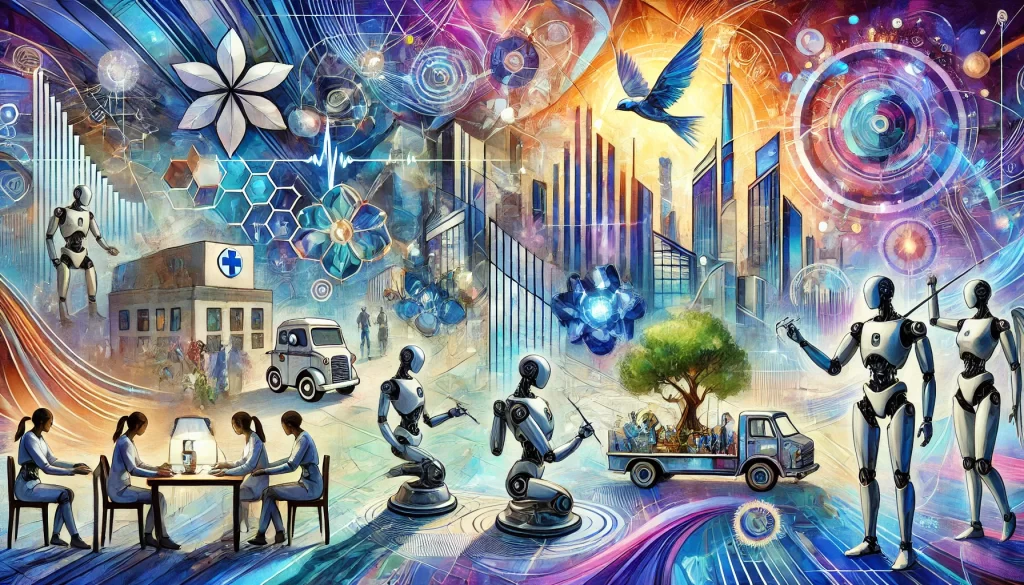Welcome to the AI revolution, where things are moving so fast, even sci-fi is struggling to keep up. With the recent release of OpenAI's O1, you'd be forgiven for thinking that AI has hit its final form. But no, my tech-loving friend, this is just the beginning of a major shift in how artificial intelligence will change the way we live, work, and even think. Please ensure your seat and tray tables are in their full upright and locked positions, because this article plunges into what you’ve missed and why OpenAI’s O1 might just be the start of something much, much bigger.
Oh, and it's not just about AI. We’re talking large world models, AI in healthcare, futuristic tools for creatives, and, yes, a few terrifying predictions for anyone hoping to remain employed as a doctor.
The Humble Beginnings of Something Huge: The OpenAI O1 Model
If you’ve heard of OpenAI's O1, you probably think it's just another step in AI’s natural progression. But as Sam Altman (CEO of OpenAI) said, this is the "beginning of a significant new paradigm." O1 isn’t just a chatbot that’s better at writing bad poetry—it’s a groundbreaking model that has shown a massive leap in AI's ability to reason, create, and even diagnose medical conditions. So let's break it down for you and make it fun while we're at it.
The Healthcare Takeover: When AI Becomes Your Doctor
OpenAI’s O1 preview didn’t just hit the medical field; it steamrolled it. Current tests show that O1 outperforms human doctors in medical diagnostics by a wide margin. Let's put that into perspective. Imagine you're at the doctor’s office. Instead of sitting there flipping through old magazines while waiting for lab results, your diagnosis is done before the nurse even gets back to check your blood pressure. That’s O1—able to digest mountains of data in seconds, leaving human doctors looking like, well, glorified WebMD pages.
Fun fact: OpenAI’s O1 is so good at diagnosing based on phenotypes that it’s already beating the pants off of previous AI models like GPT-4. Not only can it correctly identify symptoms, but it’s also getting faster and more accurate with each iteration.
Doctors vs. Robots: The Stark Prediction
A not-so-friendly prediction for aspiring doctors—AI is advancing so quickly in the field of medical diagnosis and treatment that we could see a major decline in the demand for human physicians. A recent benchmark test put O1 ahead of current doctors in diagnosing patients and even offering treatment plans. Yes, you read that right—your future doctor could be a machine, and it might even out-diagnose your human one.
But there’s hope. Doctors who specialize in areas like surgery or emergency medicine are safer... for now. Still, even these areas could be overtaken by robotic systems within a decade. So, if you’re in med school right now, you might want to consider a career pivot unless you want to compete with robots that don’t need sleep.
Thought Experiment: What if AI Replaced Doctors?
Let’s take a thought experiment: If AI like O1 becomes the go-to for diagnostics and treatment plans, will there still be a place for human doctors? While human empathy is still a critical part of patient care, AI will likely take over many tasks, leaving doctors to focus on complex surgeries and emotional support. In fact, we could be looking at a future where doctors are more like healthcare managers overseeing AI systems that diagnose and treat.
This brings up a fascinating emotional dichotomy. On the one hand, AI gives us security—less human error, faster diagnostics, and lower healthcare costs. On the other hand, it challenges our traditional sense of empathy and care. Will a robot ever be able to truly “care” for a patient?

Large World Models: AI Moving Beyond Our Screens
OpenAI’s O1 isn’t just smarter; it’s spatially aware, or at least it's heading that way, thanks to innovators like Fay F. Lee. The development of large world models—AI that can understand, generate, and interact with 3D spaces—could change everything from gaming to architecture. Think about it: A world where you tell your AI to design your dream home and boom, it's done in 3D with physics that make sure your new mansion doesn't collapse.
Let’s pull a page from history. When the Wright brothers built the first airplane, people were excited but skeptical. Now we have commercial airlines flying millions of people daily. Similarly, large world models are in their infancy, but the future is limitless. Expect to see virtual spaces become as commonplace as PowerPoint presentations are today.
Bullet List: Why Large World Models Matter
- Architecture: From sandbox games to real-world skyscrapers, large world models will help design and optimize spaces.
- Gaming: Virtual reality will take a massive leap forward, blending real-world physics with AI-generated environments.
- Robotics: AI-driven robots will understand and navigate their surroundings more intuitively.
- AR/VR: Expect virtual spaces that are interactive and lifelike, revolutionizing gaming and professional tools.
Fei F. Lee and Spatial Intelligence: The Woman Who Wants to Change How AI “Thinks”
Imagine you're building a sandcastle. Now imagine you're designing an entire city in 3D, complete with physics, logic, and traffic lights. This is the ambitious project Fei F. Lee and her team at World Labs are tackling: spatial intelligence. This groundbreaking technology will enable AI to create, interact with, and generate entire 3D worlds. You know that sandbox game your kid plays? Picture that on steroids, but for architects, engineers, and designers.
What’s the big deal? Well, while most AI is focused on 2D tasks—text, video, and images—Lee’s team is digging into how AI can truly understand and manipulate the 3D world.
Table: Comparison of 2D AI vs. Spatial Intelligence AI
| Feature | 2D AI | Spatial Intelligence AI |
|---|---|---|
| Focus | Text, video, images | 3D worlds, objects, spatial reasoning |
| Complexity | Linear | Multidimensional |
| Use Cases | Customer service, content creation | Architecture, robotics, AR/VR |
Now, just imagine the potential applications: from creating intricate virtual worlds to designing physical spaces for cities. The possibilities are endless.
The Future of Creativity: Runway’s Video-to-Video Tool
The creative space is about to explode thanks to tools like Runway's Video-to-Video. For those unfamiliar, this tool allows users to transform any video into an entirely different visual format. Think about taking your home video and turning it into a Star Wars-like sci-fi scene—all without needing Spielberg on the set.
The use cases here are practically endless. For example, in the film industry, pre-visualization is a massive time-sink. Instead of spending hours rendering CGI, studios can use Runway’s tool to get a quick look at how a scene will unfold, all in high quality.
The Bigger Picture: How Does This Affect You?
The rise of AI agents and spatial intelligence isn’t just for the tech geeks and medical field. This is going to redefine your day-to-day life. From booking flights to diagnosing illness to managing complex projects, AI is poised to become an integral part of your world.
Think about it. If AI can handle more mundane tasks—scheduling, data entry, even diagnosing your cat’s mysterious limp—you’re free to focus on things that matter: creativity, relationships, and yes, binge-watching Netflix without the guilt.
What excites you most about the AI revolution? Do you have concerns about where it's headed? Let’s hear your thoughts in the comments below.
And don’t forget—join the iNthacity community today to apply for your citizenship in the "Shining City on the Web" and stay ahead of the curve in the tech world.
FAQs: Answering Your Burning Questions About AI
1. Will AI replace doctors?
AI won't replace doctors completely, but it will take over diagnostics and routine tasks. Think of it as your doctor's super-assistant, providing faster, more accurate information. However, empathy and complex surgeries will still need human expertise... for now.
2. What is spatial intelligence in AI?
Spatial intelligence allows AI to understand and interact with 3D spaces. Imagine telling an AI to design a house, and it creates a fully interactive 3D model, complete with accurate physics and design considerations.
3. Is AI creativity real?
Yes and no. AI tools like Runway's Video-to-Video can generate creative outputs, but they lack the emotional nuance and lived experience of human creativity. Think of AI as a powerful tool to augment human creativity, rather than replace it.
4. Should I be scared of AI taking over my job?
Depends on your job. If you're in a field involving routine tasks, you might want to upskill. Creative and human-centric roles are safer... for now. But AI is advancing rapidly, and we’ll likely see major shifts in the job market in the next 5-10 years.
5. How soon will we see AI agents in everyday life?
Sooner than you think. OpenAI’s O1 is already outperforming human professionals in several areas. We’re on the cusp of AI agents becoming as common as smartphones.
6. What industries will be most impacted by AI in the next decade?
Healthcare, architecture, entertainment, and customer service are at the top of the list. Expect AI-driven innovations in everything from medical diagnostics to 3D world generation.
7. Is AI safe to use?
While AI is incredibly powerful, safety regulations, particularly in healthcare, are critical. AI’s potential is vast, but proper guidelines are essential to ensure its ethical use.
8. Will AI affect my daily life?
Absolutely. From managing your calendar to diagnosing health issues, AI will become a daily tool that makes life more efficient and personalized.
9. Can AI agents really replace human intuition?
AI can handle data-driven tasks much better than humans, but when it comes to emotional intelligence and complex decision-making, humans still have the edge... for now.
10. How can I prepare for an AI-driven future?
Start by learning how to use AI as a tool in your current field. Upskilling in data analysis, programming, or AI project management will give you an edge as these technologies become more mainstream.




















Post Comment
You must be logged in to post a comment.